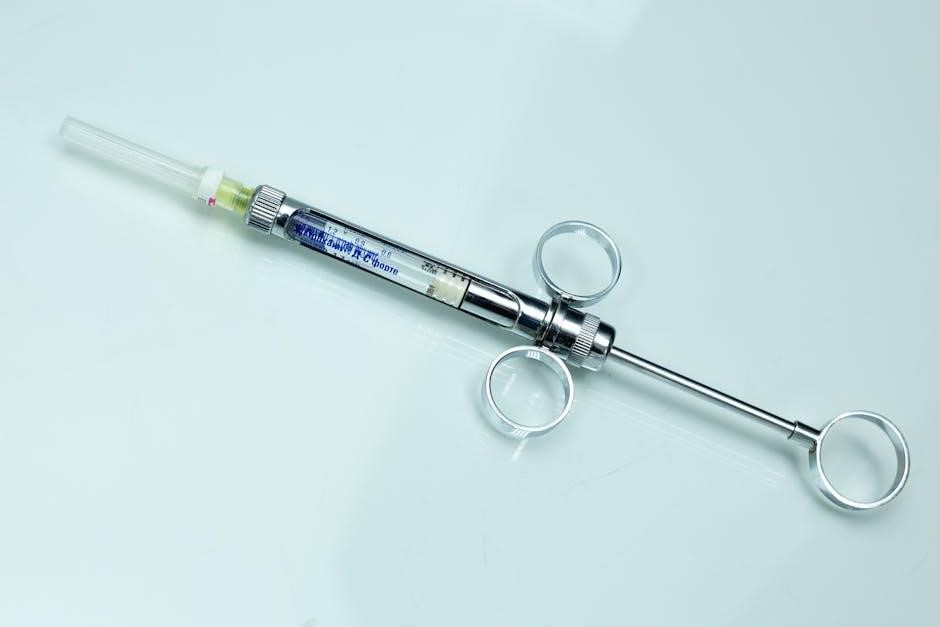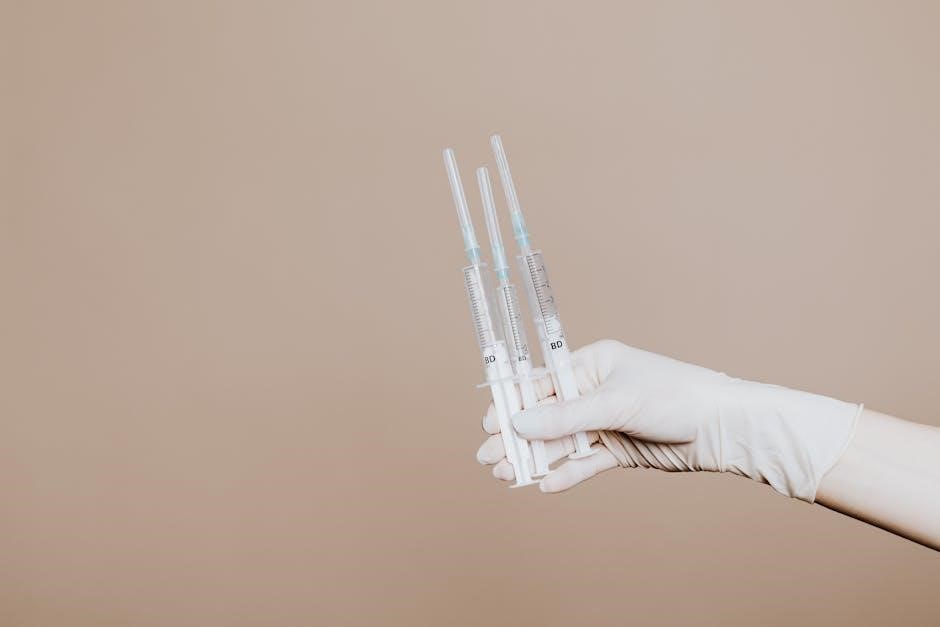Drug administration routes are methods by which medications enter the body to produce therapeutic effects. They are classified into enteral, parenteral, inhalational, and transdermal categories, each offering unique advantages for drug delivery, ensuring effectiveness, safety, and patient convenience.
1.1 Definition and Importance
The route of drug administration refers to the path by which a drug is introduced into the body to achieve its therapeutic effects. It is a critical determinant of drug absorption, bioavailability, and efficacy. The importance lies in ensuring that the drug reaches its target site effectively, while minimizing side effects. Different routes, such as oral, parenteral, or inhalational, are chosen based on factors like drug properties, patient condition, and desired action. Proper administration routes enhance therapeutic outcomes, improve patient compliance, and reduce potential risks. Understanding these pathways is essential for healthcare professionals to optimize treatment regimens and ensure safe, effective drug delivery.
1.2 Historical Overview
The history of drug administration dates back thousands of years, with early civilizations using herbal remedies and primitive methods to deliver therapeutic substances. Ancient practices included chewing plants for oral absorption or applying them topically for localized effects. The Egyptians and Greeks later developed more sophisticated techniques, such as using ointments and potions. In the Middle Ages, apothecaries refined these methods, introducing pills and elixirs. The 17th century saw the invention of injection techniques, while the 19th century brought significant advancements in parenteral routes like intravenous administration. The 20th century introduced modern innovations, including transdermal patches and inhalational devices, revolutionizing drug delivery. This evolution reflects humanity’s continuous quest to enhance therapeutic efficacy and patient care.

Classification of Drug Administration Routes
Drugs are classified into four main administration routes: enteral, parenteral, inhalational, and transdermal. These categories are based on how the drug enters the body to achieve therapeutic effects.
2.1 Enteral Routes
Enteral routes involve drug administration through the digestive system, ensuring absorption into the bloodstream. Common methods include oral, sublingual, rectal, and buccal delivery. Oral administration is the most frequently used due to its simplicity and patient compliance. Sublingual drugs, placed under the tongue, bypass first-pass metabolism, enhancing bioavailability. Rectal administration, though less common, is beneficial for local action or when oral absorption is problematic. Buccal delivery involves placing drugs between the cheek and gums for systemic absorption. These routes vary in absorption efficiency and suitability, depending on the drug’s properties and the patient’s condition, making them versatile options for diverse therapeutic needs.
2.2 Parenteral Routes
Parenteral routes involve administering drugs directly into body tissues, bypassing the digestive system. This method ensures rapid absorption and systemic effects, making it ideal for emergencies or when oral administration is ineffective. Common parenteral routes include intravenous (into a vein), intramuscular (into a muscle), subcutaneous (under the skin), and intra-arterial (into an artery) injections. Parenteral administration is highly effective for drugs with poor oral bioavailability or when immediate action is required. However, it requires proper technique and sterility to prevent complications. This route is widely used in clinical settings for antibiotics, vaccines, and chemotherapy. Parenteral drugs are typically formulated to ensure compatibility with body tissues, making them a critical component of modern pharmacotherapy. Their use is tailored to specific therapeutic needs, balancing efficacy and potential risks.
2.3 Inhalational Routes
Inhalational routes involve the administration of drugs directly into the lungs, where they are absorbed into the bloodstream. This method is commonly used for treating respiratory conditions like asthma and chronic obstructive pulmonary disease (COPD). Drugs such as bronchodilators and corticosteroids are often delivered via inhalers or nebulizers. The inhalational route offers the advantage of rapid absorption and localized action, reducing systemic side effects. It is also used for systemic drug delivery, as the lungs’ extensive vascular network allows for quick access to the bloodstream. Proper technique is essential to ensure effective drug delivery and minimize complications. This route is particularly useful for drugs that require high bioavailability or immediate action, making it a versatile option in clinical practice.
2.4 Transdermal Routes
Transdermal routes involve the administration of drugs through the skin, bypassing the digestive system. This method uses patches, gels, or ointments to deliver medication slowly and consistently. Common examples include nicotine patches for smoking cessation and nitroglycerin patches for angina. The drug diffuses through the skin layers and enters the bloodstream, providing systemic effects. Transdermal delivery offers advantages like reduced gastrointestinal side effects, improved bioavailability for certain drugs, and enhanced patient compliance due to non-invasive application. However, absorption rates can vary based on skin characteristics, temperature, and drug properties. This route is particularly useful for medications requiring controlled release over extended periods, ensuring sustained therapeutic levels in the body. Proper application and adherence to dosage guidelines are crucial for optimal efficacy and safety.

Enteral Drug Administration
Enteral drug administration involves delivering medications through the digestive tract, offering a non-invasive and convenient method with high patient compliance for systemic effects.
3.1 Oral Route
The oral route is the most commonly used method of drug administration, involving ingestion of medications through the mouth. It offers high patient compliance due to its simplicity and non-invasive nature. Drugs are absorbed primarily in the small intestine, with bioavailability influenced by factors like gastric pH, gut motility, and first-pass metabolism. This route is ideal for solid oral dosage forms such as tablets, capsules, and powders, as well as oral liquids. Despite its convenience, the oral route may be less effective for drugs requiring rapid action or those degraded by digestive enzymes. Proper formulation ensures optimal therapeutic effects, making it a preferred choice for systemic drug delivery.
3.2 Sublingual Route
The sublingual route involves placing a drug under the tongue, where it dissolves and is directly absorbed into the bloodstream through the sublingual veins. This bypasses the digestive system, avoiding first-pass metabolism and allowing for rapid onset of action. It is particularly useful for drugs with high potency or those that are unstable in the gastrointestinal tract. Common examples include nitroglycerin for angina and certain hormonal medications. The sublingual route offers quick therapeutic effects, making it ideal for emergency situations or conditions requiring immediate relief. However, it may not be suitable for patients with difficulty managing sublingual tablets or those with conditions affecting mucosal absorption. Proper administration ensures optimal efficacy and patient comfort.
3.3 Rectal Route
The rectal route involves administering drugs through the rectum, often in the form of suppositories or enemas. This method bypasses the digestive system, reducing first-pass metabolism and improving bioavailability for certain drugs. It is particularly useful for patients with gastrointestinal disorders, nausea, or those unable to take oral medications. The rectal mucosa absorbs drugs directly into the bloodstream, providing localized or systemic effects. Common examples include anti-inflammatory agents, antihistamines, and laxatives. However, rectal absorption can be variable due to rectal blood flow and motility. Patient discomfort and inconvenience are potential drawbacks. Despite these limitations, the rectal route remains a viable option for specific clinical scenarios, offering a practical alternative to oral administration when necessary. Proper formulation and administration techniques are essential to ensure therapeutic efficacy.
3.4 Buccal Route
The buccal route involves placing a drug between the cheek and gum, where it dissolves and is absorbed through the buccal mucosa into the bloodstream. This method bypasses the digestive system, enhancing bioavailability and reducing first-pass metabolism. It is particularly effective for drugs requiring rapid action, such as nitroglycerin for angina. Buccal absorption is generally faster than sublingual due to the larger surface area and higher blood flow in the cheek tissue. Factors like saliva production and mucosal integrity can influence drug absorption. patient compliance is high due to the non-invasive nature of this route. However, only certain drugs are suitable for buccal administration, and formulations must be specifically designed for this purpose. This route is a convenient and efficient alternative to oral and parenteral methods in appropriate clinical situations.

Parenteral Drug Administration
Parenteral administration involves injecting drugs directly into body tissues, bypassing the digestive system. This route ensures rapid absorption and systemic effects, commonly used for emergencies or when oral routes are ineffective.
4.1 Intravenous Route

The intravenous route involves administering drugs directly into a vein, providing immediate systemic circulation. This method is highly effective for emergency medications, ensuring rapid action and precise dosing. It bypasses absorption barriers, making it ideal for critical care and when oral administration isn’t feasible. Commonly used in hospitals, IV administration requires skilled personnel to minimize complications like phlebitis or infection. Drugs delivered intravenously have 100% bioavailability, enhancing therapeutic effects. This route is essential for medications that are poorly absorbed or unstable outside the bloodstream, ensuring optimal efficacy and patient safety.
4.2 Intramuscular Route
The intramuscular route involves injecting drugs directly into muscle tissue, typically in the thigh, deltoid, or gluteal muscles. This method allows for slow absorption of the drug into the bloodstream, providing a depot effect that prolongs therapeutic action. It is commonly used for vaccines, antibiotics, and medications requiring sustained release. Advantages include avoidance of first-pass metabolism and improved bioavailability for certain drugs. However, it may cause local pain, swelling, or tissue irritation. Proper technique is essential to ensure safety and efficacy, making it a preferred route for medications that are not effective orally but do not require immediate action.
4.3 Subcutaneous Route
The subcutaneous route involves injecting drugs into the fatty tissue just beneath the skin, typically in areas like the abdomen, upper arm, or thigh. This method allows for gradual absorption into the bloodstream, offering sustained drug levels. It is commonly used for medications such as insulin, vaccines, and certain hormones. Advantages include ease of administration, reduced risk of hitting blood vessels, and lower risk of infection compared to intramuscular injections. Patients can often self-administer subcutaneous injections, enhancing convenience. However, local reactions like redness or swelling may occur. Proper injection technique is crucial to ensure effectiveness and minimize discomfort, making this route ideal for long-term therapies and chronic conditions.
4.4 Intra-arterial Route
The intra-arterial route involves the direct injection of drugs into an artery, delivering the medication to a specific area of the body. This method is often used for localized treatment, such as chemotherapy for cancers or certain infections. Advantages include targeted delivery, reducing systemic side effects, and ensuring higher drug concentration at the site of action. However, it carries risks like arterial damage, thrombosis, or tissue necrosis if the drug inadvertently leaks. It requires precise technique and is typically performed in a clinical setting by trained professionals. This route is highly specialized and used for specific therapeutic purposes, making it less common than other parenteral methods. Proper patient monitoring is essential to minimize complications and ensure safety.